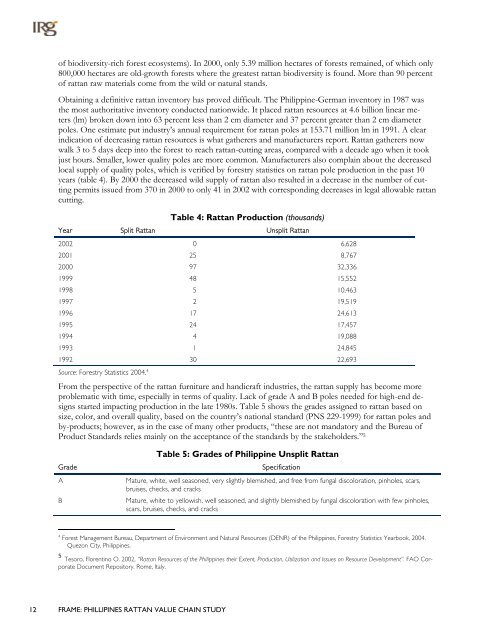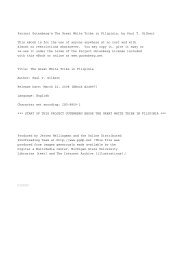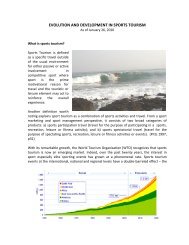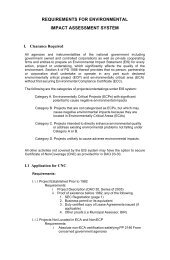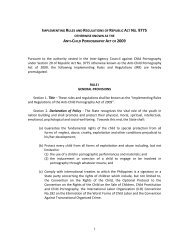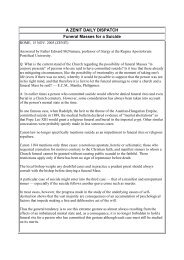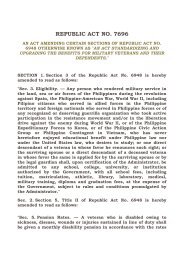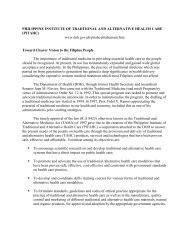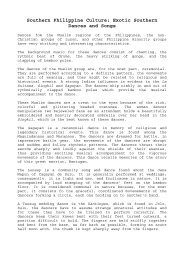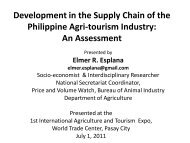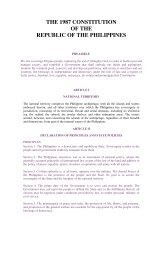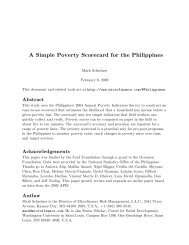PHILIPPINES RATTAN VALUE CHAIN STUDY - About the Philippines
PHILIPPINES RATTAN VALUE CHAIN STUDY - About the Philippines
PHILIPPINES RATTAN VALUE CHAIN STUDY - About the Philippines
Create successful ePaper yourself
Turn your PDF publications into a flip-book with our unique Google optimized e-Paper software.
of biodiversity-rich forest ecosystems). In 2000, only 5.39 million hectares of forests remained, of which only<br />
800,000 hectares are old-growth forests where <strong>the</strong> greatest rattan biodiversity is found. More than 90 percent<br />
of rattan raw materials come from <strong>the</strong> wild or natural stands.<br />
Obtaining a definitive rattan inventory has proved difficult. The Philippine-German inventory in 1987 was<br />
<strong>the</strong> most authoritative inventory conducted nationwide. It placed rattan resources at 4.6 billion linear meters<br />
(lm) broken down into 63 percent less than 2 cm diameter and 37 percent greater than 2 cm diameter<br />
poles. One estimate put industry’s annual requirement for rattan poles at 153.71 million lm in 1991. A clear<br />
indication of decreasing rattan resources is what ga<strong>the</strong>rers and manufacturers report. Rattan ga<strong>the</strong>rers now<br />
walk 3 to 5 days deep into <strong>the</strong> forest to reach rattan-cutting areas, compared with a decade ago when it took<br />
just hours. Smaller, lower quality poles are more common. Manufacturers also complain about <strong>the</strong> decreased<br />
local supply of quality poles, which is verified by forestry statistics on rattan pole production in <strong>the</strong> past 10<br />
years (table 4). By 2000 <strong>the</strong> decreased wild supply of rattan also resulted in a decrease in <strong>the</strong> number of cutting<br />
permits issued from 370 in 2000 to only 41 in 2002 with corresponding decreases in legal allowable rattan<br />
cutting.<br />
Table 4: Rattan Production (thousands)<br />
Year Split Rattan Unsplit Rattan<br />
2002 0 6,628<br />
2001 25 8,767<br />
2000 97 32,336<br />
1999 48 15,552<br />
1998 5 10,463<br />
1997 2 19,519<br />
1996 17 24,613<br />
1995 24 17,457<br />
1994 4 19,088<br />
1993 1 24,845<br />
1992 30 22,693<br />
Source: Forestry Statistics 2004. 4<br />
From <strong>the</strong> perspective of <strong>the</strong> rattan furniture and handicraft industries, <strong>the</strong> rattan supply has become more<br />
problematic with time, especially in terms of quality. Lack of grade A and B poles needed for high-end designs<br />
started impacting production in <strong>the</strong> late 1980s. Table 5 shows <strong>the</strong> grades assigned to rattan based on<br />
size, color, and overall quality, based on <strong>the</strong> country’s national standard (PNS 229-1999) for rattan poles and<br />
by-products; however, as in <strong>the</strong> case of many o<strong>the</strong>r products, “<strong>the</strong>se are not mandatory and <strong>the</strong> Bureau of<br />
Product Standards relies mainly on <strong>the</strong> acceptance of <strong>the</strong> standards by <strong>the</strong> stakeholders.” 5<br />
Grade<br />
A<br />
B<br />
Table 5: Grades of Philippine Unsplit Rattan<br />
Specification<br />
Mature, white, well seasoned, very slightly blemished, and free from fungal discoloration, pinholes, scars,<br />
bruises, checks, and cracks<br />
Mature, white to yellowish, well seasoned, and slightly blemished by fungal discoloration with few pinholes,<br />
scars, bruises, checks, and cracks<br />
4<br />
Forest Management Bureau, Department of Environment and Natural Resources (DENR) of <strong>the</strong> <strong>Philippines</strong>, Forestry Statistics Yearbook, 2004.<br />
Quezon City, <strong>Philippines</strong>.<br />
5 Tesoro, Florentino O. 2002, “Rattan Resources of <strong>the</strong> <strong>Philippines</strong> <strong>the</strong>ir Extent, Production, Utilization and Issues on Resource Development”. FAO Corporate<br />
Document Repository. Rome, Italy.<br />
12 FRAME: PHILLIPINES <strong>RATTAN</strong> <strong>VALUE</strong> <strong>CHAIN</strong> <strong>STUDY</strong>


